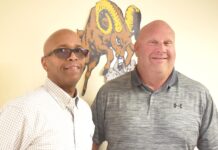[quote_box_right]Upcoming College and Career Ready Events at MHS
Dollars for Scholars Scholarship Bootcamp, May 28-29, 8 a.m.-noon at MHS Library
Standing out in the Admissions Process, June 4-5, 8 a.m.-noon at MHS Library
Events are appropriate for all high school students, grades 9-12. For more information, contact Bernadette Russoniello at [email protected].[/quote_box_right]
By Bernadette Russoniello

Applying for scholarships could be a full-time job for high school students. Yet most students are unaware and unprepared for the work required.
Daily, I hear comments from students such as, “Miss, I spent like four hours working on applying, and I found nothing,” “It’s only a thousand dollars, it’s not worth the work” and “I wish I would’ve started sooner!”
Simply by earning all A’s and B’s, students manage to earn at least $27 for every hour they are in high school through university academic scholarships. Students need to invest time up front in building a scholarship application portfolio and a researched action plan to maximize their chances at earning monies.
What’s a scholarship portfolio? I encourage students to start a digital portfolio of all elements typically required for applications. At MHS, we use Google Apps for Education, so starting a folder in their Google Drive is the first step. Gather and develop basic elements required for most scholarships: three letters of recommendation, an updated resume, a list of awards and honors, personal statements including reflections on your career and college goals, a personal narrative describing yourself and an updated high school transcript.
Tips on letters of recommendation. Ask well before you need one. I have students asking regularly for letters the day before they are due. Ask in advance, and make sure to give a five- to 10-day window. After the first week, gentle reminders are appreciated to ensure you receive your letter on time. Additionally, providing your recommender your resume and personal narrative helps them include points about you they may not know. And most importantly, pick people who are strong writers and know you well – specific examples and personal anecdotes are what readers look for, not a regurgitation of the resume.
Standing out. Admissions and scholarship readers read literally hundreds, if not thousands, of applications. The applicant must stand out in the process, either through their voice, their story or their accomplishments. Accomplishments are the toughest; all students applying are in clubs, get great grades and serve as campus leaders. What do you do that makes you different?
Where to start? I’m a fan of Scholarships.com – but not the “Free Search” (unless you love spam and third-party emails). I show students how to use the “Directory” feature to search by category and due date. Students need to develop an action plan that allows them to list scholarships, links, application needs and due dates.
This column appears in the May issue of InMaricopa.


![Who’s the Best Mom InMaricopa? Nominate now! Marlene Marshall, Christina Olivares, and Meghan Bremer. [Bryan Mordt]](https://www.inmaricopa.com/wp-content/uploads/2023/05/BCM_8465-218x150.jpg)









![Alleged car thief released without charges Phoenix police stop a stolen vehicle on April 20, 2024. [Facebook]](https://www.inmaricopa.com/wp-content/uploads/2024/04/IMG_5040-218x150.jpg)

![3 things to know about the new city budget Vice Mayor Amber Liermann and Councilmember Eric Goettl review parts of the city's 2024 operational budget with Mayor Nancy Smith on April 24, 2024. [Monica D. Spencer]](https://www.inmaricopa.com/wp-content/uploads/2024/04/spencer-042424-preliminary-budget-meeting-web-100x70.jpg)


